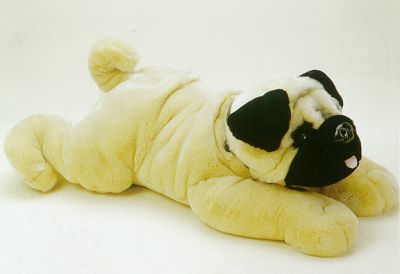The Best Care
and Food for
your Pug
|
|
A Basket of Beautiful Pug Puppies

Please Help Homeless Pets with a One Dollar Gift
Pug - One Happy Go Lucky Pup
This info on Pugs presented to you by Tippy
The Pug is an affectionate, animated, lively, loyal, loving,
happy-go-lucky, peppy, playful and rambunctious dog. They
are very affectionate and loving towards their family and
are sure to be the clown that keeps everyone laughing.
They are highly intelligent but bore easily if not given
variety in their training, and if they sense that they have
a stronger will than their owners they can become willful.
So beware of "small dog syndrome". Pugs are sensitive to the
human tone of voice. Harsh punishments are not needed to
keep this dog in line. Be sure to be calm, firm and
consistent when training or correcting your Pug.
Pugs make great watchdogs and they aren't yappers like other
small dogs. This dog isn't dull nor is it excitable. They
get along fine with other dogs and household pets. They are
well behaved around children and strangers. Some of the Pugs
talents include performing tricks and being a watchdog.
The males can reach twelve to fourteen inches in height and
weigh between thirteen and twenty pounds. The females reach
a height of between ten to twelve inches and weigh thirteen
to eighteen pounds. Pugs normally live twelve to fifteen
years.
When stressed or in cold weather the Pug will easily catch a
cold. Because of their extremely short muzzles they are
prone to allergies and chronic breathing problems, they have
a tendency to snore and wheeze. Like their relatives the
English Bulldogs, Pugs suffer from over all poor
ventilation.
Pugs are vulnerable to a number of health problems. They are
susceptible to some skin problems, and the Pug's eyes weep.
There is the chance of inflammation of the cornea, called
Keratites. They also sometimes suffer from PDE, or Pug Dog
Encephalitis, that strikes when the dog is two and three
years of age. In PDE the brain becomes inflamed and the
cause is unknown.
Be sure not to overfeed your Pug as they will eat more than
they need and quickly become overweight and have a much
shorter life expectancy because of it. Also, the large heads
mean that they do not whelp easily and most often the female
dogs have to undergo Caesarian section to deliver.
The Pug makes a great apartment dog and is relatively
inactive indoors. They do fine with a yard to play around
in. They cannot withstand extremes in temperature at all.
They should be kept indoors at all times and when it is very
hot or cold outside they shouldn't be walked but instead
paper train them so they can stay indoors in bad weather.
When the temperature allows your Pug should be taken on a
daily walk to take care of its physical and psychological
needs. Be sure to use proper leash etiquette with this dog.
Pugs love to play games and will do much better if given
regular exercise every day, but if the dog starts wheezing
it should be made to rest. This dog should never be over-
exerted as they have problems breathing.
The Pug's short-haired, smooth coat is easy to groom. Brush
with a firm bristle brush or comb when necessary. Bathe or
dry shampoo only when necessary. Be sure to thoroughly dry
the dog after the bath so that it doesn't become chilled.
The creases on the face should be cleaned regularly to avoid
skin irritation. Wipe the eyes with a damp cloth to clean
away weepage. This dog is a seasonal heavy shedder.
Pug

Your Pug Needs High Quality Dog Food and Treats
Jane Bicks, D.V.M.
The Pug, with their tiny, sweet, pushed in face,
big eyes, and wrinkled skin needs a diet of high
quality protein and fat.
The Perfect Mouth Watering Dog Food for your Pug
The addition of antioxidants in a natural form is recommended.
Antioxidant Treats any Pug will Find Healthy and Scrumptious
If shedding becomes a problem, add a fatty acid supplement.
How Incredibly Sweet - Stuffed Plush Pugs

Dog Breeds - Find out everything about Them
Charismatic Gift Items for Pugs and Pug Lovers
Search about Pugs and Dogs
|